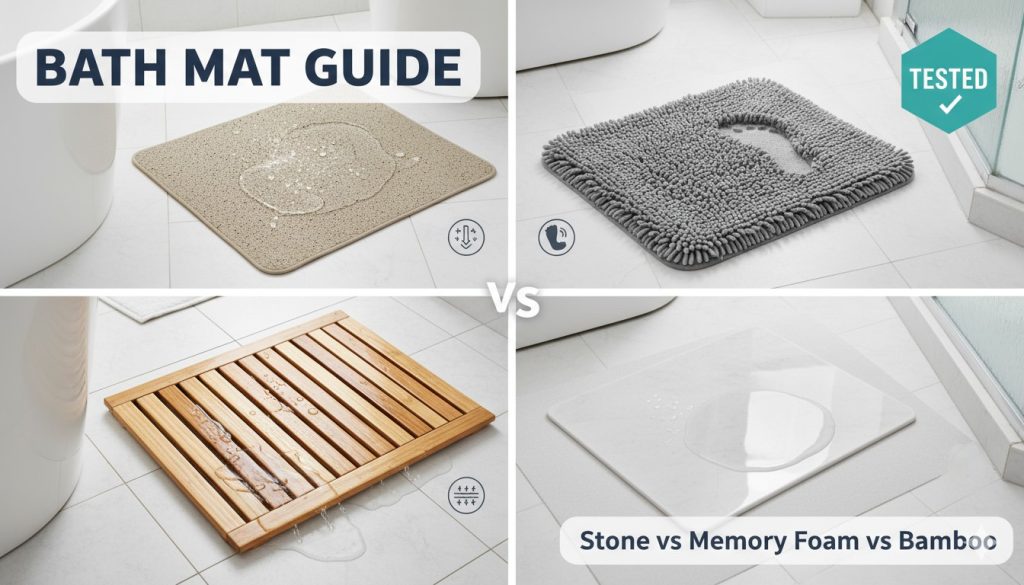
Stepping out of a hot shower onto a cold, wet bathroom floor is one of those small annoyances that can ruin an otherwise perfect morning. I used to think all bath mats were basically the same—just different colors and patterns of the same absorbent fabric. Then I slipped on my soggy memory foam mat one too many times and decided it was time to figure out what actually works.
What I discovered surprised me. Bath mats have come a long way from those traditional terry cloth rectangles our parents used. Today’s options range from space-age stone surfaces to eco-friendly bamboo slats, each with completely different approaches to handling water. Understanding how these materials actually work changed the way I think about this humble bathroom essential, and it’ll help you choose the perfect mat for your needs too.
Stone Bath Mats: The Trendy Moisture-Wicking Option
Do Stone Bath Mats Work?
I’ll be honest—when I first saw stone bath mats showing up everywhere online, I was skeptical. Standing on a rock after a shower? It sounded uncomfortable and gimmicky. But after three months of using one in my main bathroom, I’m a convert with some caveats.
Stone bath mats absolutely work for their intended purpose: getting water off your feet quickly. Within seconds of stepping onto mine, my feet feel dry enough to walk on carpet without leaving wet footprints. That said, they’re not magic solutions for every bathroom situation. If you have young kids who splash water everywhere or you’re dealing with a very humid bathroom, you’ll still see some pooling around the edges.
The real question isn’t whether they work, but whether they work for your specific needs. In my experience, they’re fantastic for adults who want a low-maintenance option and don’t mind a firmer surface underfoot.
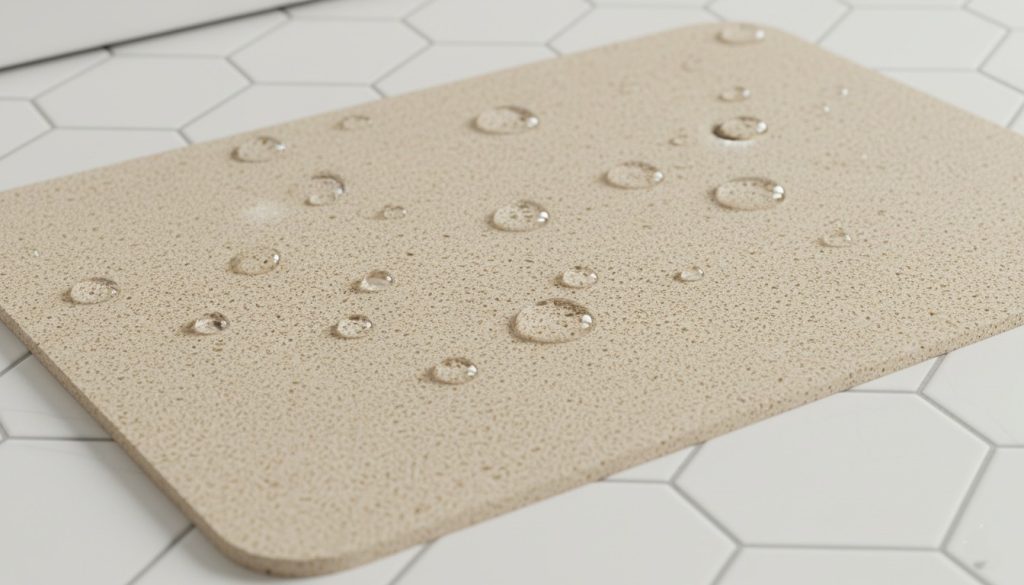
The Science Behind Water Absorption
Here’s what fascinated me about stone mats: they don’t absorb water the way fabric does. Instead, they pull moisture into millions of tiny pores through capillary action, then release it into the air through evaporation. Think of it like a super-powered sponge made of minerals.
Most stone mats are made from diatomaceous earth, pumice stone, or similar porous materials. The surface is riddled with microscopic holes that wick water away from your feet almost instantly. When I first stepped on mine, it felt bizarre—my feet went from dripping wet to mostly dry in about five seconds. The mat itself feels slightly damp for maybe ten minutes, then returns to completely dry.
The catch is that this process only works efficiently if you maintain the mat properly. I learned this the hard way when I noticed mine wasn’t performing as well after a few weeks. Stone mats need good air circulation to evaporate the water they’ve absorbed. Propping mine against the wall after use instead of leaving it flat on the floor made a noticeable difference. Also, you need to sand it lightly every month or so to open up those pores again—they can get clogged with soap residue and skin cells.
Safety Considerations
One concern I had was slipping on what’s essentially a smooth stone surface. Surprisingly, the texture provides decent natural grip when both the mat and your feet are wet. The slightly rough, porous surface creates friction that works better than I expected.
However, I wouldn’t rely on texture alone for safety. My stone mat came with a thin rubber backing, but it wasn’t enough to keep it completely stationary on my tile floor. I added some rubber corner grips (the kind you use for area rugs), and that solved the problem. If you have very smooth tile or you’re buying one for an elderly family member, look for models with more substantial non-slip features or plan to add your own.
One more thing: check whether your floor can handle the weight. Stone mats are heavy—mine weighs about seven pounds. That’s fine for standard tile or vinyl, but if you have radiant heated floors, verify with the manufacturer that the weight and insulation properties won’t interfere with the heating.
Bamboo Bath Mats: The Eco-Friendly Alternative
Performance and Functionality: Do Bamboo Bath Mats Work?
After using a bamboo mat in my guest bathroom for over a year, I can confidently say they work, but with a completely different philosophy than other mats. Bamboo doesn’t try to absorb water—it lets it drain right through.
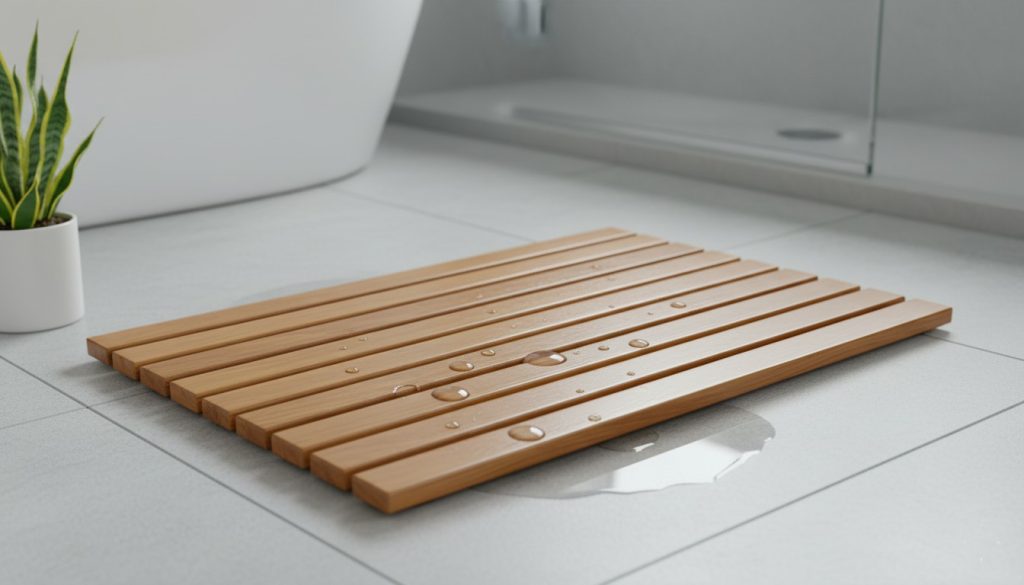
My bamboo mat consists of wooden slats held together with rust-resistant wire or silicone connectors. When I step on it, water drips between the slats onto the floor below. This sounds messy, but it actually works brilliantly if you place it strategically. I put mine over a low-profile waterproof tray, creating a two-layer system. The water drains through the bamboo, collects in the tray, and both pieces dry quickly because air circulates around them.
The durability question was my main concern initially. Would a wooden mat hold up to constant moisture? A year in, mine still looks nearly new. Bamboo naturally resists mold and mildew better than most woods, and it doesn’t warp or split the way I’ve seen cheaper wooden mats do. The key is letting it dry completely between uses—don’t leave it sitting in standing water.
Advantages and Limitations
The antimicrobial properties of bamboo are real. I’ve never seen any mold or mildew on mine, even during humid summer months when my fabric mats would start smelling musty. Bamboo contains a natural antimicrobial agent called bamboo kun that inhibits bacterial growth. For someone who hates constantly washing bath mats, this is a game-changer.
Maintenance is minimal. Every few weeks, I wipe mine down with a damp cloth, maybe use a little mild soap if there’s any soap scum buildup. Once every couple of months, I’ll apply some mineral oil to keep the wood from drying out. Compare that to throwing fabric mats in the wash every week, and bamboo is significantly less hassle.
The main limitation is comfort. Standing on wooden slats isn’t plush. If you like that spa-like softness under your feet, bamboo won’t deliver. It’s also not ideal for bathrooms where water splashes far beyond where you’re standing, since bamboo only handles the water that lands directly on it. My guest bathroom works perfectly because it’s a small space with minimal splash zone. In my kids’ bathroom where bath time resembles a water park, bamboo would be completely inadequate.
Memory Foam Bath Mats: Comfort Meets Function
Understanding the Technology: How Do Memory Foam Bath Mats Work?
Memory foam mats are what I used for years before branching out into other materials, so I know them intimately—both their strengths and their frustrations. The technology is actually clever: you’ve got a thick layer of memory foam sandwiched between a microfiber top and a water-resistant backing.
When you step onto the mat, the memory foam compresses under your weight, contouring to your feet. It feels luxurious, honestly. After standing on cold tile, that cushioned surface is like a little moment of comfort. The microfiber top layer is designed to absorb water quickly, pulling moisture away from your feet through its dense, ultra-fine fibers.
Here’s how it actually works: microfiber strands are so thin and tightly packed that they create enormous surface area for water absorption. When your wet foot makes contact, water moves into these tiny spaces between fibers through capillary action. Meanwhile, the memory foam below provides support and bounce-back. The bottom layer is usually made of non-slip rubber or latex to keep everything in place.
Water Management
This is where memory foam mats get tricky, and why I eventually experimented with other options. Yes, the microfiber absorbs water effectively—my feet feel dry when I step off. But the mat itself stays damp for hours. In my main bathroom with limited ventilation, my memory foam mat wouldn’t fully dry between morning and evening showers.
I timed it once out of curiosity. After a typical shower, the surface felt dry to the touch within about thirty minutes, but the foam layer stayed damp for three to four hours. If you’re in a household where multiple people shower in quick succession, that mat is essentially always wet. That’s not just uncomfortable—it becomes a breeding ground for mildew.
The backing material matters more than I initially realized. My first memory foam mat had a cheap rubber backing that started to deteriorate after about six months, leaving black crumbles on my floor. When I upgraded to one with a higher-quality thermoplastic rubber (TPR) backing, it lasted much longer and maintained better grip. You get what you pay for with these mats.
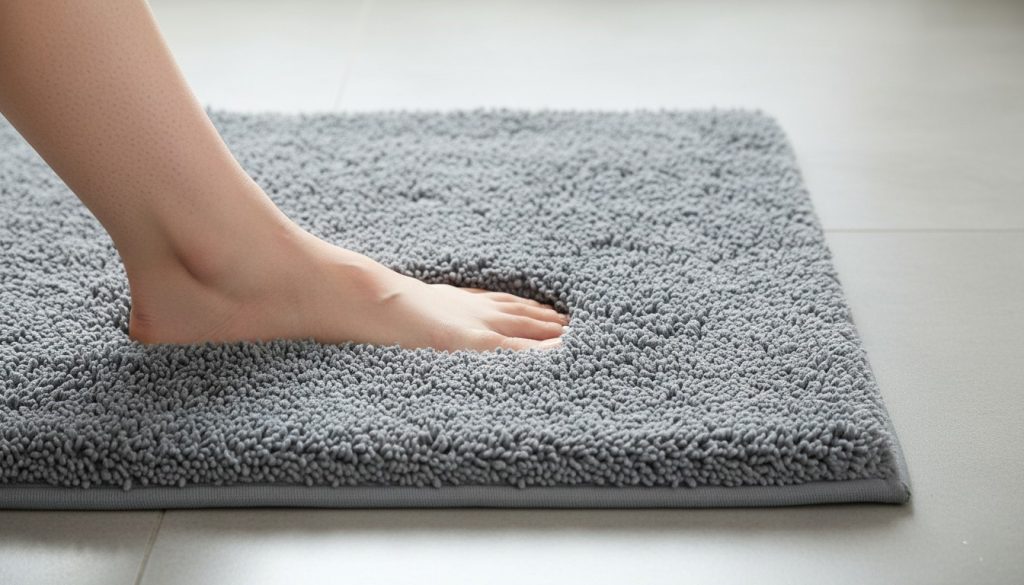
When does comfort trump quick-drying properties? For me, it’s in low-traffic bathrooms or when I know I’m dealing with cold floors and want that cozy feeling. I keep a memory foam mat in my basement bathroom that only gets used occasionally. In that context, it’s perfect—maximum comfort, and it has plenty of time to dry between uses.
When does comfort trump quick-drying properties? For me, it’s in low-traffic bathrooms or when I know I’m dealing with cold floors and want that cozy feeling. I keep a memory foam mat in my basement bathroom that only gets used occasionally. In that context, it’s perfect—maximum comfort, and it has plenty of time to dry between uses.
hat said, these mats aren’t indestructible. I did notice that after dropping a heavy bottle on mine, it developed a small chip at the edge. The material is harder than regular stone but still brittle. If you’re buying one, treat it carefully—don’t drop it during installation, and avoid putting heavy objects on it.
Cleaning is straightforward but essential. Every couple of weeks, I lightly sand the surface with fine-grit sandpaper (around 220 grit) to remove any buildup and refresh those pores. It takes maybe two minutes. Once a month, I’ll wash it with mild soap and water, let it dry completely, then do the sanding. This maintenance routine keeps it performing like new.

Safety Profile
The natural texture of diatomaceous earth provides excellent grip when wet. It’s slightly rougher than regular stone, which I actually prefer—it feels more secure underfoot. I’ve never experienced even a hint of slipping on the surface itself.
The weight is substantial, though. My diatomaceous mat weighs about eight pounds, which makes it naturally resistant to sliding around. Still, the smooth bottom needs some help staying put. I use small rubber corner pads, and the mat hasn’t budged since. The weight-to-grip ratio actually works in your favor here—once you’ve secured it properly, it’s not going anywhere.
If you’re setting one up for someone elderly or with mobility issues, I’d recommend adding silicone grip pads underneath despite the natural friction. Better safe than sorry, and the added security is worth the extra step during setup.
Critical Safety Feature: Non-Slip Effectiveness
Why Safety Matters
I’m going to share something embarrassing. Two years ago, I slipped getting out of the shower and caught myself on the towel bar, which promptly pulled out of the wall. I wasn’t hurt beyond a bruised ego and some wall damage, but it scared me. Bathroom falls are no joke—they’re one of the leading causes of home injuries, especially for older adults.
That incident is what kicked off my entire bath mat research journey. I realized I’d been prioritizing aesthetics and comfort over the one feature that actually matters most: keeping me from falling on a wet floor while I’m naked and disoriented from shower steam.
Evaluating Non-Slip Technology Across Mat Types
Non-slip effectiveness varies dramatically depending on the mat material and what’s on the bottom. After testing multiple types, I’ve developed a system for evaluating grip that’s served me well.
Rubber backing is the most common non-slip feature, but not all rubber is created equal. My memory foam mat has a textured rubber bottom with small bumps that create friction against the floor. It works well on my tile, providing solid grip even when the underside gets slightly damp. However, I tried the same mat on my friend’s smooth vinyl floor, and it slid around terribly. The lesson: rubber grip performance depends heavily on your floor type.

Stone and diatomaceous mats typically have smooth bottoms, relying on their weight for stability. This works to an extent—they don’t shift easily under normal use. But weight alone isn’t enough if you’re stepping onto them with force or shifting your weight suddenly. I learned to add a supplementary grip to all my heavy mats.
Bamboo mats often have rubberized feet or strips on the underside. Mine has four rubber dots on the corners and two strips running lengthwise. This design provides decent stability while still allowing air circulation underneath for drying. It’s a smart compromise, though I did add extra grip pads because I’m paranoid after my towel bar incident.
The Role of Suction Cups
Suction cup functionality deserves its own discussion because these features can be hit or miss. I’ve used several mats with suction cups, and they only work properly under specific conditions.
First, the surface matters enormously. Suction cups create grip by forming an airtight seal, which requires a completely smooth, non-porous surface. They work brilliantly on smooth tile, glass, or acrylic tub surrounds. On textured tile, stone, or any surface with grout lines, they’re essentially useless. I made this mistake with my first suction cup mat—bought it without considering that my bathroom has textured tile for better traction. The cups couldn’t seal properly, and the mat slid around worse than if it had no cups at all.
Second, suction cups require proper installation. You can’t just toss the mat down and expect them to work. I learned to press each cup firmly until I feel it seal, working out any air bubbles. Every few weeks, I lift the mat, clean both the cups and the floor, and reapply. Soap residue and moisture prevent proper sealing, so this maintenance is essential.
Whether suction cups are necessary or optional depends on where you’re placing the mat. For mats inside the tub or shower where they’ll be constantly soaked, suction cups are critical. For mats on the floor outside the shower, a good rubber backing is usually sufficient. I use a suction cup mat inside my tub and a rubber-backed mat on the floor—different tools for different jobs.
Common suction cup failures happen when people don’t maintain them. The cups lose flexibility over time, especially with temperature changes from hot water. If your suction cups are more than a year old and aren’t gripping well, they might need replacing. Some mats have replaceable cups, which is a feature I now look for specifically.
Hybrid approaches work best in my experience. My favorite shower mat has both suction cups and a textured rubber surface. The suction cups provide primary stability, while the rubber texture acts as backup friction. This redundancy means that if a suction cup fails, I’m not suddenly on a slippery surface.
Testing Non-Slip Claims
Here’s my embarrassingly simple but effective test for non-slip performance: I get the mat wet, stand on it, and twist my feet back and forth while shifting weight. If the mat moves at all, it needs better grip. If it stays completely stationary, it passes.
When reading product descriptions, I’ve learned to decode the marketing language. “Non-slip backing” is vague—look for specifics like “TPR rubber backing,” “suction cup technology,” or “textured grip surface.” Photos of the underside are crucial. If a product listing doesn’t show you what’s on the bottom, that’s a red flag.
I also pay attention to weight specifications now. Lighter mats under two pounds will slide more easily regardless of their backing material. Heavier mats (over five pounds) have natural stability working in their favor.
Another red flag is the absence of any grip features on lightweight fabric mats. I see a lot of cheap microfiber mats online with completely smooth bottoms and no mention of non-slip properties. These are accidents waiting to happen, no matter how pretty the pattern is.
Making Your Decision: Which Mat Is Right for You?
By Household Type
Choosing the right mat depends heavily on who’s using it and how often. In my house, I’ve ended up with different mat types in different bathrooms because each situation has unique demands.
For families with children, durability trumps everything else. Kids are rough on bathroom equipment—mine have a talent for turning bath time into a splash zone that extends three feet beyond the tub. I use a memory foam mat in their bathroom because it’s washable, comfortable for their little feet, and I can throw it in the dryer when it inevitably becomes a soggy mess. The quick-drying properties of stone would be wasted since it would be perpetually soaked anyway.
For elderly or mobility-challenged users, safety becomes the absolute priority. My parents are in their seventies, and I’ve set up their bathroom with a diatomaceous earth mat that has added rubber grip pads underneath. The fast-drying surface means there’s never standing water to step in, and the natural texture provides secure footing. I also made sure it’s positioned where they naturally step when exiting the shower, so there’s no reaching or awkward angles involved.
High-traffic bathrooms need something low-maintenance. My main bathroom gets used by my wife and me twice daily, so I have a stone mat that doesn’t require washing and dries completely between uses. The last thing I want is another item on my laundry rotation.
Guest bathrooms are where I get to use the pretty stuff. My bamboo mat looks beautiful and eco-friendly, and since it only gets used occasionally, the wooden slats have plenty of time to dry completely between uses. It’s become a conversation starter—guests always ask about it.
By Bathroom Conditions
The humidity level in your bathroom matters more than I initially realized. My main bathroom has a good exhaust fan, which means mats dry relatively quickly. The half-bath in my basement has no ventilation beyond leaving the door open, which completely changes the equation.
In humid environments, quick-drying materials are essential. Stone and diatomaceous earth are your friends here. Memory foam and traditional fabric mats will develop mildew problems in poorly ventilated spaces—I learned this the hard way in that basement bathroom before I switched to stone.
Floor type affects your options, too. If you have smooth tile like me, you can use virtually any mat with the right non-slip additions. If you have textured tile for safety (common in modern bathrooms), suction cups won’t work, so focus on rubber-backed options or weighted mats.
Space constraints matter. Stone and diatomaceous earth mats don’t fold or compress, so they take up fixed space. If you have a tiny bathroom where you need to move the mat regularly to access storage or clean, a fabric mat might be more practical despite other drawbacks. My powder room is so small that I actually use a small bamboo mat that I can easily lean against the wall when needed.
By Priority
If your top priority is speed of drying, diatomaceous earth and stone mats are unbeatable. My diatomaceous mat is bone-dry fifteen minutes after use, while my memory foam mat is still damp four hours later. For households with multiple people showering in sequence, this difference is significant.
For comfort, memory foam wins hands down. That cushioned surface feels amazing, especially on cold mornings. If you have foot pain, plantar fasciitis, or just enjoy a spa-like bathroom experience, the tradeoff of slower drying might be worth it.
Eco-friendliness? Bamboo is your answer. It’s a rapidly renewable resource, biodegradable at end-of-life, and requires minimal processing compared to synthetic materials. My bamboo mat has also lasted longer than any fabric mat I’ve owned, which means less waste from replacements.
For overall safety considering both grip and drying speed, I’d rank diatomaceous earth first (fast-drying surface plus good texture), stone second (similar properties but slightly slower evaporation), memory foam third (good grip backing but stays wet), and bamboo last (water drains through rather than being absorbed, which can create puddles if not set up properly).
Maintenance Tips for Maximum Performance
Every mat type needs some care to perform its best. Here’s what I’ve learned through trial and error about keeping each type in optimal condition.
For stone and diatomaceous earth mats, the maintenance schedule is surprisingly simple. Every two to three weeks, I lightly sand the surface with fine-grit sandpaper to reopen the pores. This takes maybe ninety seconds and makes a noticeable difference in absorption speed. Monthly, I wash the mat with mild soap and water, let it air dry completely (usually takes about an hour), then sand it again. That’s it. No machine washing, no fabric softener, no complicated care routines.
What damages these mats? Dropping them, for one—they’re brittle despite their weight. Harsh chemical cleaners can also clog the pores permanently. I stick to gentle dish soap or castile soap, nothing with heavy fragrances or oils. Also, don’t let them sit in standing water for extended periods. They’re designed to absorb and release moisture, not to be perpetually soaked.
Memory foam mats need frequent washing, especially in humid bathrooms. I wash mine every week or two by machine on a gentle cycle with cold water. Hot water can damage the foam and backing. I never put it in the dryer—the heat degrades the rubber backing and can warp the foam. Instead, I hang it over the shower rod or lay it flat in a well-ventilated area. Even air-drying takes several hours, which is why I have a backup mat for rotation.
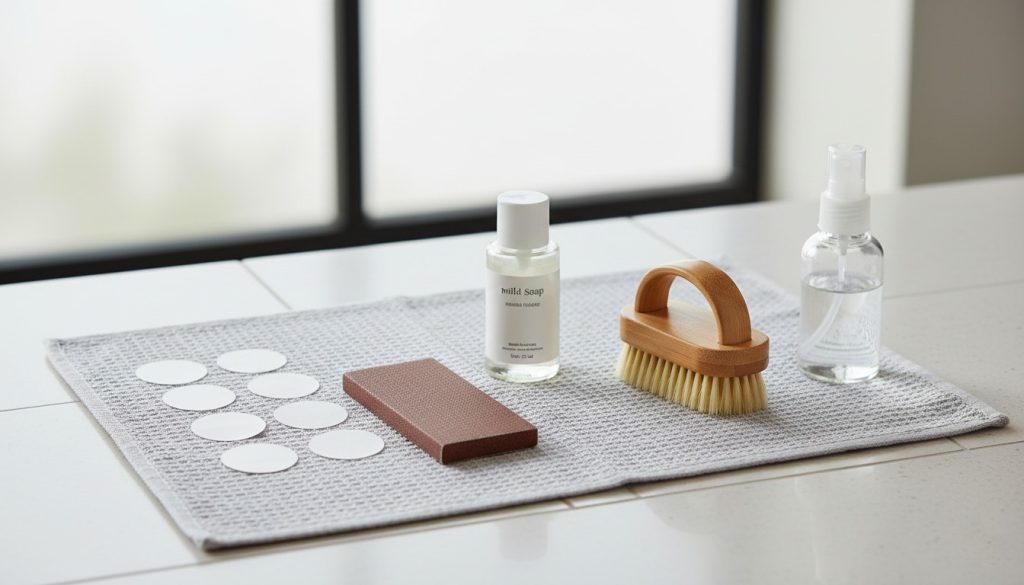
For bamboo mats, the routine is minimal. I wipe mine down with a damp cloth every couple of weeks, occasionally using a drop of dish soap if there’s buildup. Every month or two, I apply mineral oil to the wood to prevent drying and cracking. This keeps it looking fresh and extends its life. The wire or silicone connectors need checking occasionally—mine has held up perfectly, but I’ve seen reviews where cheaper mats have connectors that rust or snap.
When to replace versus refresh? Memory foam mats need replacing when the backing starts to deteriorate or the foam loses its bounce-back. Mine last about twelve to eighteen months with regular use. Stone and diatomaceous earth mats can last years if maintained properly—I see no end in sight for mine after eight months. Bamboo mats should be replaced when the wood starts to splinter or warp, which can take several years with proper care.
For guest bathroom mats that sit unused for weeks at a time, I’ve learned to store them propped against the wall or in a closet rather than flat on the floor. This prevents dust accumulation and ensures good air circulation. My bamboo mat lives permanently in place, but my spare memory foam mat stays in the linen closet between guest visits.
Conclusion
After months of testing different bath mats, living with them daily, and dealing with their quirks, I’ve concluded there’s no single “best” mat for everyone. Your perfect bath mat depends on your household dynamics, bathroom conditions, personal priorities, and yes, even your floor type.
What I can say definitively is this: prioritize safety features above everything else. A beautiful mat that matches your décor is worthless if it contributes to a fall. Make sure whatever mat you choose has appropriate non-slip technology for your specific floor, and don’t hesitate to add supplementary grip pads if needed. That extra two dollars for corner grips is the best insurance policy you can buy.
My personal setup has evolved into a strategic deployment of different mat types. Quick-drying stone in my high-traffic main bathroom. Comfortable memory foam in the kids’ bathroom where it’ll be washed regularly anyway. Attractive bamboo in the guest bathroom for occasional use. Each mat serves its specific purpose perfectly, and I no longer have the frustration of soggy, smelly mats that don’t perform.
The right bath mat genuinely improves your daily routine and bathroom safety. It’s one of those small household details that you don’t think about until something goes wrong—or until you discover how much better it can be. Take the time to assess your needs, understand how different materials work, and invest in quality over cheap options. Your feet (and your dignity when you don’t slip and pull down the towel bar) will thank you.
Leave a Reply